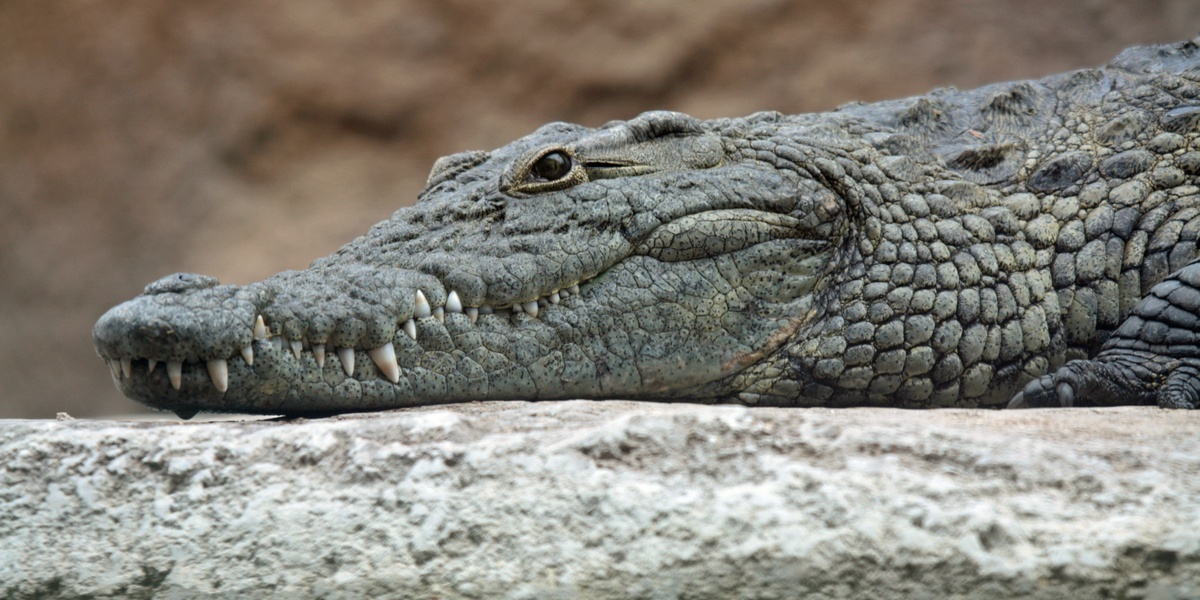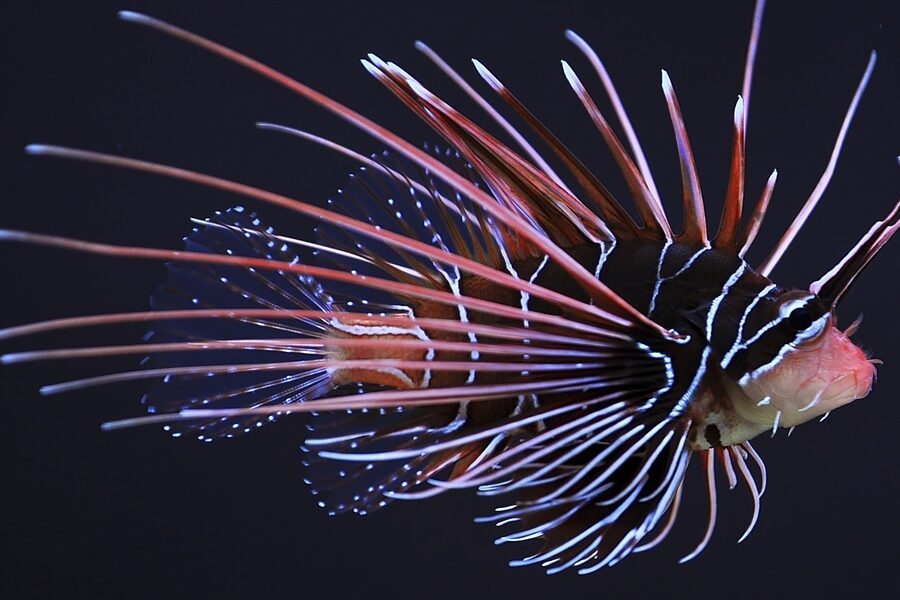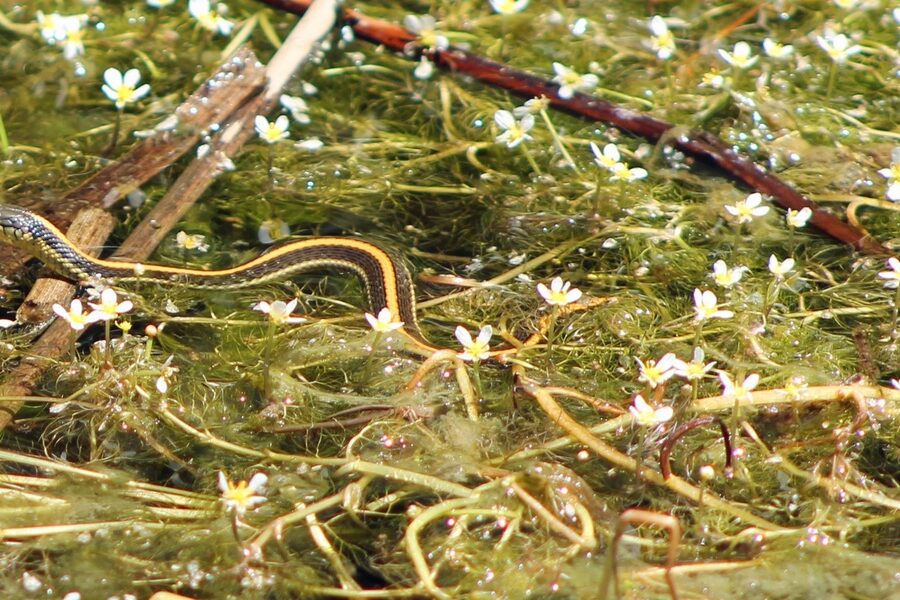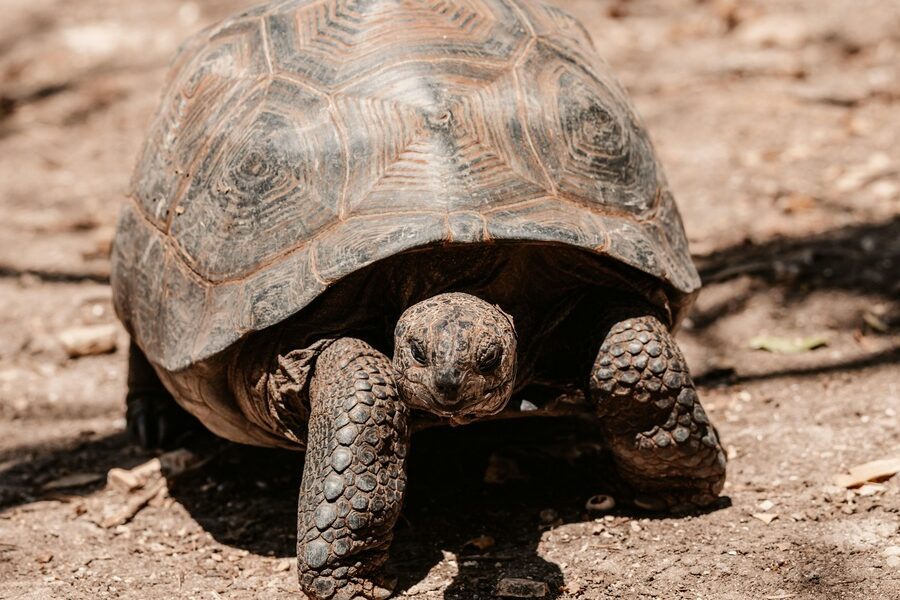Mali’s mix of Sahel, riverine floodplains and southern savanna supports a surprising variety of reptiles that often go unnoticed between seasonal rains and dry spells. From riverbanks to rocky outcrops, these species play key roles in local food webs and can reveal changes in habitat health.
There are 83 Reptiles of Mali, ranging from Adanson’s Mud Turtle to White-lipped Herald Snake. For each species the list shows Scientific name,Distribution & habitat,IUCN status — details you’ll find below.
Which parts of Mali have the most reptile species?
Most species are concentrated in southern and riverine zones, especially along the Niger River and seasonal wetlands where water and vegetation persist; savanna woodlands also host many snakes and lizards, while the northern desert has fewer, more specialized reptiles. Local surveys can reveal pockets of diversity tied to microhabitats like rocky outcrops or irrigated fields.
How up-to-date are the IUCN statuses listed here?
The IUCN status in the list reflects assessments available from IUCN at the time of compilation, but some entries may lag behind recent field surveys or taxonomic changes; treat the statuses as a reliable starting point and consult the IUCN Red List or recent local studies for the latest updates.
Reptiles of Mali
| Common name | Scientific name | Distribution & habitat | IUCN status |
|---|---|---|---|
| West African Crocodile | Crocodylus suchus | Southern rivers, wetlands like the Niger Inner Delta; avoids saline water. | Not Evaluated |
| West African Slender-snouted Crocodile | Mecistops cataphractus | Historically in southern rivers; extremely rare or extirpated from Mali. | Critically Endangered |
| African Spurred Tortoise | Centrochelys sulcata | Sahelian and southern Saharan scrublands; digs deep burrows to escape heat. | Endangered |
| Bell’s Hinge-back Tortoise | Kinixys belliana | Southern Sudanian savannas and woodlands, preferring areas with dense vegetation. | Not Evaluated |
| African Helmeted Turtle | Pelomedusa subrufa | Widespread in ponds, marshes, and slow-moving rivers across the country. | Least Concern |
| Adanson’s Mud Turtle | Pelusios adansonii | Niger River and associated wetlands, preferring slow-moving, shallow water with vegetation. | Least Concern |
| West African Mud Turtle | Pelusios castaneus | Southern Mali’s savannas and wetlands; found in temporary and permanent water bodies. | Least Concern |
| Nile Softshell Turtle | Trionyx triunguis | Large rivers like the Niger and Senegal; requires sandy banks for nesting. | Vulnerable |
| Savannah Monitor | Varanus exanthematicus | Widespread in savannas and grasslands, avoiding dense forest and true desert. | Least Concern |
| Nile Monitor | Varanus niloticus | Aquatic habitats along the Niger and Senegal rivers and their floodplains. | Least Concern |
| Common Agama | Agama agama | Ubiquitous in rocky areas, savannas, and human settlements across the country. | Not Evaluated |
| Malian Agama | Agama boueti | Rocky outcrops and arid savannas of central and western Mali. | Least Concern |
| Geyr’s Spiny-tailed Lizard | Uromastyx geyri | Saharan massifs like the Adrar des Ifoghas; requires rocky, arid environments. | Vulnerable |
| Mali Spiny-tailed Lizard | Uromastyx maliensis | Endemic to rocky areas in the Mali-Algeria border region. | Not Evaluated |
| African Chameleon | Chamaeleo africanus | Sahelian and Sudanian savannas, often near rivers and wetlands with trees. | Least Concern |
| Graceful Chameleon | Chamaeleo gracilis | Humid savannas and woodlands of southern Mali; adaptable to farmland. | Least Concern |
| Brook’s House Gecko | Hemidactylus brookii | Extremely common in and around human dwellings and savannas throughout Mali. | Least Concern |
| Ragazzi’s Fan-footed Gecko | Ptyodactylus ragazzii | Rocky outcrops, cliffs, and sometimes buildings in arid and semi-arid regions. | Least Concern |
| Petri’s Sand Gecko | Stenodactylus petrii | Saharan sand seas (ergs); a true desert specialist living in fine sand. | Least Concern |
| Saddle-backed Wall Gecko | Tarentola ephippiata | Arid savannas and Sahelian scrubland, often found on trees and rock faces. | Least Concern |
| Five-lined Skink | Trachylepis quinquetaeniata | Rocky savannas and open woodlands across the Sudanian and Sahelian zones. | Least Concern |
| Bosc’s Fringe-toed Lizard | Acanthodactylus boskianus | Sandy and gravelly areas in the Sahel and Sahara; a fast-moving diurnal lizard. | Least Concern |
| Sudan Plated Lizard | Gerrhosaurus major | Savannas and rocky scrublands, often living in burrows or termite mounds. | Least Concern |
| Ball Python | Python regius | Southern savannas and open woodlands; often hides in mammal burrows or termite mounds. | Near Threatened |
| African Rock Python | Python sebae | Savannas and floodplains, always near a permanent water source. | Not Evaluated |
| Puff Adder | Bitis arietans | Widespread in all habitats except dense forest and extreme desert. | Least Concern |
| West African Carpet Viper | Echis ocellatus | Dry savannas and Sahelian scrub, often abundant in agricultural areas. | Least Concern |
| White-bellied Carpet Viper | Echis leucogaster | Sahelian and Saharan transitional zones, preferring sandy or rocky arid habitats. | Least Concern |
| Saharan Horned Viper | Cerastes cerastes | Sandy and rocky deserts of the Sahara; famous for its prominent “horns”. | Least Concern |
| Sahara Sand Viper | Cerastes vipera | Fine sand dunes of the Sahara desert; a small, hornless viper. | Least Concern |
| Egyptian Cobra | Naja haje | Dry savannas, steppes, and semi-deserts, often near oases or agricultural land. | Least Concern |
| Black-necked Spitting Cobra | Naja nigricollis | Widespread in savannas and semi-deserts, often found near water. | Least Concern |
| Katian Spitting Cobra | Naja katiensis | Sudanian and Sahelian savannas of West Africa, named after Kati, Mali. | Least Concern |
| Senegalese Cobra | Naja senegalensis | Savannas of southern and western Mali; recently recognized as a distinct species. | Not Evaluated |
| Western Green Mamba | Dendroaspis viridis | Gallery forests and woodlands in the humid, southernmost part of Mali. | Least Concern |
| Boomslang | Dispholidus typus | Wooded savannas in southern Mali; strictly arboreal. | Least Concern |
| Hissing Sand Snake | Psammophis sibilans | Widespread in savannas and grasslands, often near water sources. | Least Concern |
| Schokari Sand Snake | Psammophis schokari | Arid and semi-arid regions of the Sahel and Sahara. | Least Concern |
| Moila Snake | Malpolon moilensis | Sandy and rocky deserts of the Sahara; a large and fast-moving species. | Least Concern |
| Brown House Snake | Lamprophis fuliginosus | Extremely common in a variety of habitats, including farms and houses. | Least Concern |
| Common Egg-eater | Dasypeltis sahelensis | Savannas and woodlands, particularly in areas with abundant nesting birds. | Least Concern |
| Forest Vine Snake | Thelotornis kirtlandii | Humid woodlands and gallery forests in southern Mali; highly arboreal. | Least Concern |
| Small-scaled Burrowing Asp | Atractaspis microlepidota | Arid savannas and steppes; a semi-fossorial, nocturnal species. | Least Concern |
| West African Night Adder | Causus maculatus | Moist savannas and floodplains, often active after rains. | Least Concern |
| Müller’s Sand Boa | Eryx muelleri | Sahelian sandy soils and arid scrublands. | Least Concern |
| Dorr’s Racer | Bamanophis dorri | Rocky outcrops and arid savannas, especially in the Bandiagara Escarpment. | Least Concern |
| Spotted Bush Snake | Philothamnus semivariegatus | Savannas and woodlands, especially near water; highly arboreal. | Least Concern |
| Rufous Beaked Snake | Rhamphiophis oxyrhynchus | Dry savannas and scrubland; semi-fossorial and diurnal. | Least Concern |
| Diadem Snake | Spalerosophis diadema | Arid and semi-arid rocky or sandy areas in the Sahelian and Saharan zones. | Least Concern |
| North African Cat Snake | Telescopus tripolitanus | Arid rocky areas, steppes, and semi-deserts. | Least Concern |
| Algerian Threadsnake | Myriopholis algeriensis | Arid environments, living underground in loose soil and sand. | Least Concern |
| Common Blind Snake | Letheobia caeca | Moist savannas and agricultural land in southern Mali; fossorial. | Least Concern |
| Horseshoe Whip Snake | Hemorrhois hippocrepis | Rocky, sun-exposed habitats in the northern Sahel, often near human settlements. | Least Concern |
| Striped House Snake | Boaedon lineatus | Southern savannas, often found near human habitation and agricultural areas. | Least Concern |
| Ocellated Skink | Chalcides ocellatus | Dry, sunny areas with some vegetation cover in Sahelian regions. | Least Concern |
| Band-bellied Skink | Sphenops delislii | Sandy desert regions of the Sahara, a true psammophile (sand-lover). | Least Concern |
| Changeable Sand Lizard | Trapelus mutabilis | Sandy and gravelly plains in the Sahara and Sahel. | Least Concern |
| Bibron’s Agama | Agama impalearis | Northern Mali, in rocky mountainous areas of the Sahara. | Least Concern |
| African Five-lined Skink | Lepidothyris perrotetii | Moist savannas and forest edges in southern Mali. | Least Concern |
| Peter’s Writhing Skink | Mochlus afer | Southern moist savannas; lives in leaf litter and soft soil. | Least Concern |
| Banded Skink | Scincopus fasciatus | Northern Sahelian zone, in areas with soft, sandy soil. | Least Concern |
| Northern Fringe-toed Lizard | Acanthodactylus dumerilii | Saharan sand deserts; a fast-moving diurnal species of sand dunes. | Least Concern |
| Long-tailed Sand Lizard | Latastia longicaudata | Arid savannas and semi-deserts across the Sahelian zone. | Least Concern |
| Spotted Sand Lizard | Mesalina guttulata | Rocky and gravelly deserts in the Sahara and northern Sahel. | Least Concern |
| Elegant Gecko | Stenodactylus sthenodactylus | Sandy and stony plains in the Sahel and Sahara; a common nocturnal gecko. | Least Concern |
| Northern Wall Gecko | Tarentola parvicarinata | Sahelian zone, common on trees (especially acacia) and on buildings. | Least Concern |
| Olive Marsh Snake | Natriciteres olivacea | Marshes, swamps, and river floodplains in southern Mali. | Least Concern |
| West African Shovel-snout | Prosymna meleagris | Savannas in southern Mali; a small, secretive, burrowing snake. | Least Concern |
| Diadem Sand Snake | Lytorhynchus diadema | Sandy deserts and arid steppes of the Sahara and Sahel. | Least Concern |
| False Smooth Snake | Macroprotodon cucullatus | Northern Sahel in Mali, preferring habitats with some cover like rocks or shrubs. | Least Concern |
| Semiornate Smooth Snake | Meizodon semiaureus | Southern Mali’s Sudanian savanna zone; a secretive, terrestrial snake. | Least Concern |
| Smyth’s Water Snake | Grayia smythii | Aquatic habitats in the southernmost part of Mali; highly aquatic. | Least Concern |
| White-lipped Herald Snake | Crotaphopeltis hotamboeia | Moist savannas, often near water, throughout southern Mali. | Least Concern |
| Slender File Snake | Gonionotophis gracilis | Humid savannas and gallery forests of southern Mali. | Least Concern |
| Semi-banded Wolf Snake | Lycophidion semicinctum | Savannas of southern Mali; a secretive, nocturnal species. | Least Concern |
| Ornate Sand Racer | Psammophis praeornatus | West African savannas, including southern Mali. | Least Concern |
| African Shovel-nosed Snake | Scaphiophis albopunctatus | Savannas across southern Mali; a powerful burrower. | Least Concern |
| Trape’s Garter Snake | Elapsoidea trapei | Savannas of western Mali; a venomous but secretive species. | Least Concern |
| Egyptian Sand Racer | Psammophis aegyptius | Extreme northern Mali, in the heart of the Saharan desert, usually near oases. | Least Concern |
| Rock Gecko | Pristurus rupestris | Rocky outcrops (massifs) in the Saharan regions of northern Mali. | Least Concern |
| Southern Five-lined Skink | Trachylepis maculilabris | Extreme southern Mali in humid savanna and gallery forest. | Least Concern |
| Western Forest File Snake | Gonionotophis poensis | Gallery forests and humid woodlands in the far south. | Least Concern |
| Weil’s Tree Snake | Dipsadoboa weileri | Humid forest and savanna mosaics in southern Mali; nocturnal and arboreal. | Least Concern |
Images and Descriptions
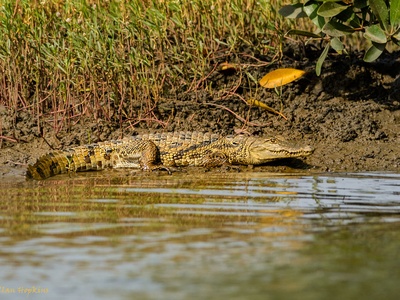
West African Crocodile
A medium-sized crocodile up to 4 meters, now recognized as a distinct species from the Nile crocodile. It is generally less aggressive and feeds on fish and small mammals. Its wetland habitats are threatened by agricultural expansion and dam construction.
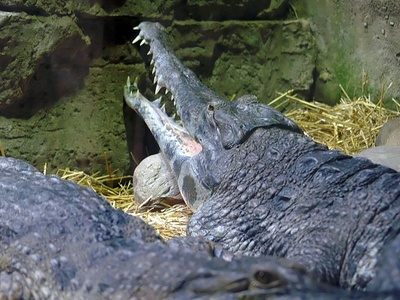
West African Slender-snouted Crocodile
A critically endangered, fish-eating crocodile with a remarkably long, slender snout. Its survival in Mali is uncertain due to intense hunting pressure and severe habitat degradation in the southern river systems where it once lived.
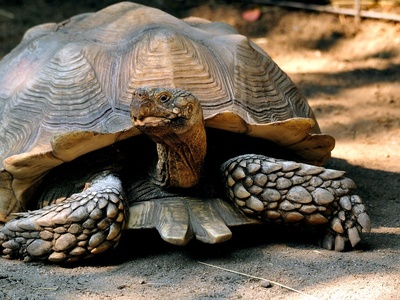
African Spurred Tortoise
The world’s third-largest mainland tortoise, known for prominent conical spurs on its front and hind legs. This powerful burrower is threatened by desertification, overgrazing, and collection for the international pet trade, making it a key conservation concern.
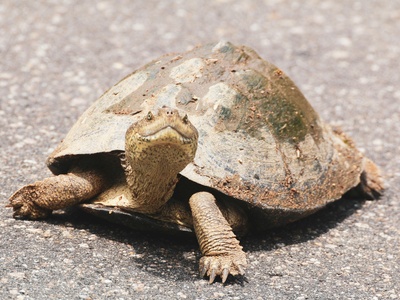
Bell’s Hinge-back Tortoise
This tortoise is named for the unique hinge on the back of its upper shell (carapace), which can close to protect its hind legs. It is an omnivore, feeding on a wide variety of plants, fungi, and invertebrates.
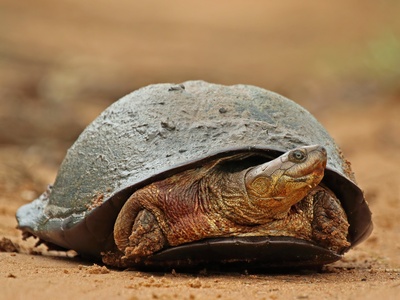
African Helmeted Turtle
A highly adaptable semi-aquatic turtle named for its large head, which it cannot fully retract. Instead, it tucks its head to the side under the shell. It is a voracious carnivore and scavenger, playing a key role in aquatic cleanup.
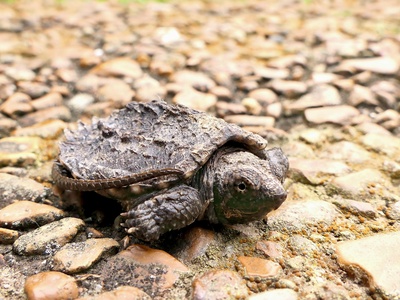
Adanson’s Mud Turtle
A small, dark-colored turtle with a distinct pattern of yellow lines on its head. It is highly aquatic and spends most of its time foraging for insects, mollusks, and small fish in the muddy bottoms of rivers and swamps.
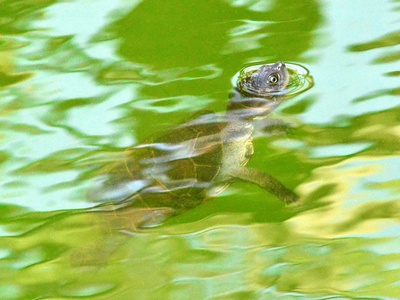
West African Mud Turtle
A common, medium-sized turtle with a smooth, dark brown or black shell. It is an omnivore with a varied diet and is known for its ability to survive dry seasons by burying itself in the mud, a process called aestivation.
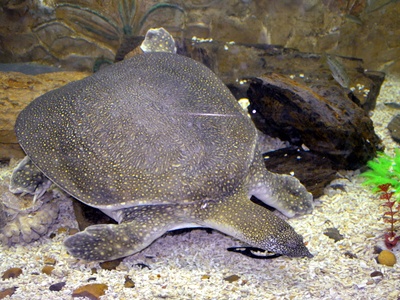
Nile Softshell Turtle
A very large, flat-bodied aquatic turtle with a leathery shell instead of a hard one. It is a powerful swimmer and an ambush predator of fish. Populations are declining due to hunting for its meat and degradation of nesting sites.
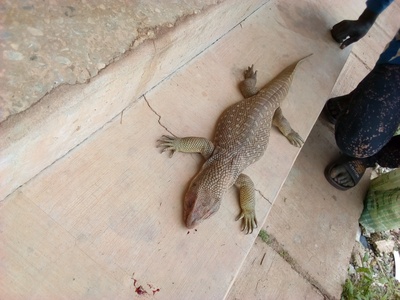
Savannah Monitor
A stocky, medium-sized monitor lizard with a powerful build and strong claws for digging. It actively forages for insects, snails, and small vertebrates during the day. It is often persecuted but is adaptable to human-modified landscapes.
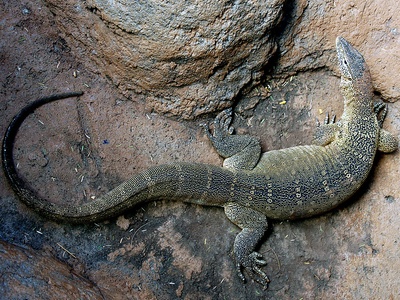
Nile Monitor
Africa’s largest lizard, reaching over 2 meters long. It is a semi-aquatic, powerful predator that eats anything it can overpower, including fish, birds, eggs, and carrion. Its intelligence and adaptability allow it to thrive even near human settlements.
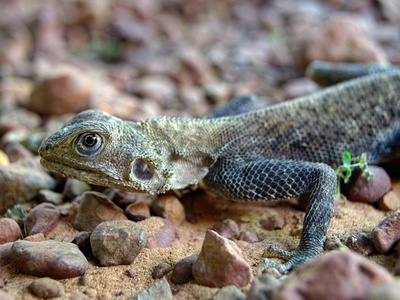
Common Agama
A familiar sight in many villages, this lizard is famous for the dominant male’s brilliant orange or red head and deep blue body. They live in social groups and are often seen basking on walls and rocks, performing “push-up” displays.
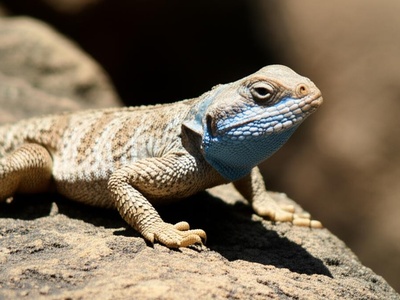
Malian Agama
A medium-sized, ground-dwelling agama with a flattened body adapted for seeking refuge in rock crevices. Males develop a pale blue or whitish head during the breeding season, contrasting with their mottled brown body.
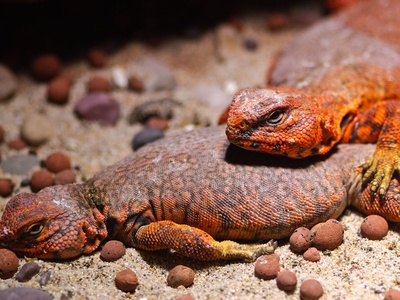
Geyr’s Spiny-tailed Lizard
A colorful, medium-sized lizard, often displaying bright yellow or red patterns on a dark background. It lives in colonies in extremely arid rock formations. Over-collection for the pet trade is the primary threat to this species.
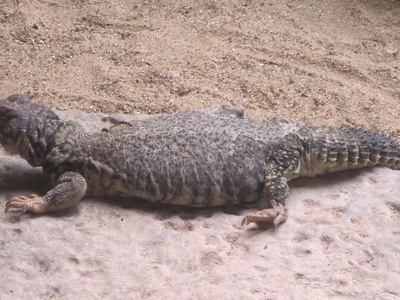
Mali Spiny-tailed Lizard
A highly sought-after species endemic to Mali, prized for its striking jet-black coloration with yellow or orange bands. It is herbivorous and uses its formidable spiky tail for defense against predators and to block its burrow entrance.
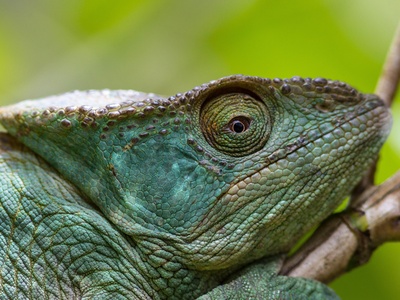
African Chameleon
A large chameleon, typically green or brownish-gray, capable of significant color change. It is an arboreal ambush predator, using its long, sticky tongue to catch insects. It can adapt to agricultural landscapes if sufficient vegetation remains.
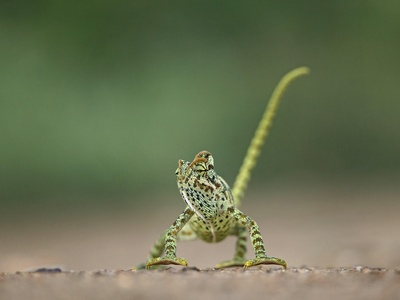
Graceful Chameleon
A slender, medium-sized chameleon with a small casque on its head and a white stripe along its flank. It is less colorful than many chameleons but is an active hunter of insects and other small prey in shrubs and tall grasses.
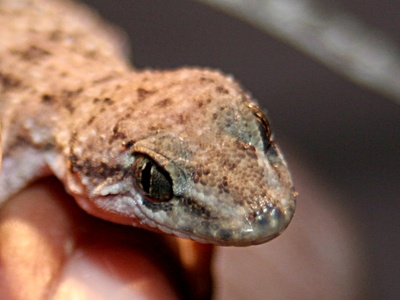
Brook’s House Gecko
A small, nocturnal gecko, often seen on walls near lights hunting insects. Its adaptable nature and association with humans have allowed it to become one of the most widespread geckos in Africa. Its toe pads allow it to climb sheer surfaces with ease.
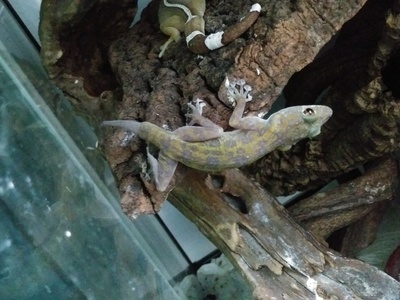
Ragazzi’s Fan-footed Gecko
A nocturnal rock-dwelling gecko recognized by its large eyes and distinctive fan-like toe pads. These specialized toes allow it to move with incredible speed and agility across vertical rock faces while hunting for insects.
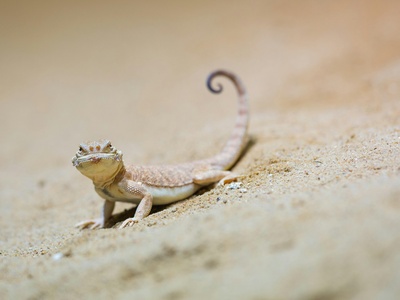
Petri’s Sand Gecko
A small, pale gecko perfectly adapted to life in sandy deserts. Its webbed feet act like snowshoes, allowing it to move easily across loose sand. It is nocturnal, emerging at night to hunt for small insects and spiders.
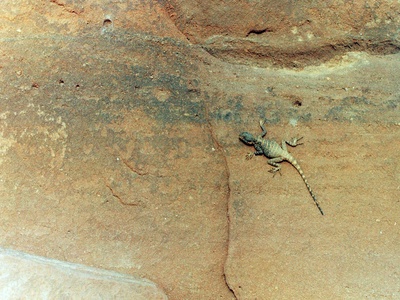
Saddle-backed Wall Gecko
A large, robust gecko with a distinctive dark, saddle-like pattern across its back. It is a nocturnal hunter with a loud, chirping call. Its rough skin and strong claws are adaptations for climbing on bark and rock.
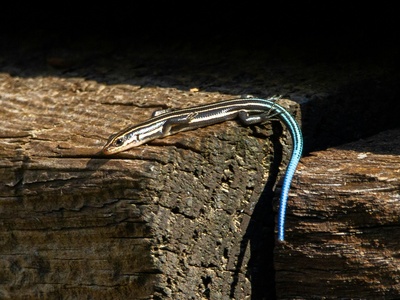
Five-lined Skink
A common, sun-loving skink easily identified by the breeding male’s bright orange or red head and the juvenile’s electric blue tail. Females and non-breeding males have five distinct light stripes running down their dark backs.
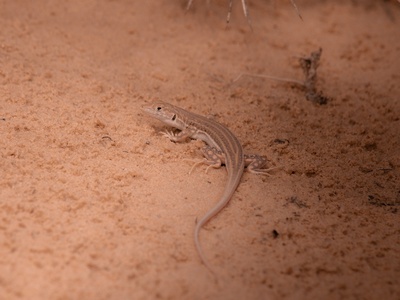
Bosc’s Fringe-toed Lizard
A slender lizard named for the comb-like scales (fringes) on its toes, which provide traction on loose sand. It is an active, diurnal hunter that darts across open ground in search of insects, especially ants and termites.
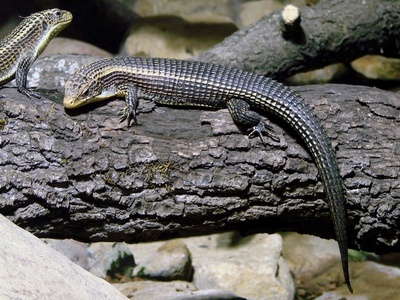
Sudan Plated Lizard
A large, heavily-built lizard with a robust body covered in plate-like scales. It is slow-moving and omnivorous, feeding on insects, small vertebrates, and plant matter. Despite its size, it can be quite shy and quick to retreat to its burrow.
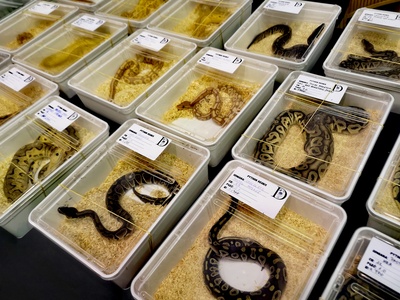
Ball Python
A small, docile python famous for its defensive habit of rolling into a tight ball. Its beautiful patterns and calm temperament have made it extremely popular in the pet trade, and over-collection is a major threat to wild populations.
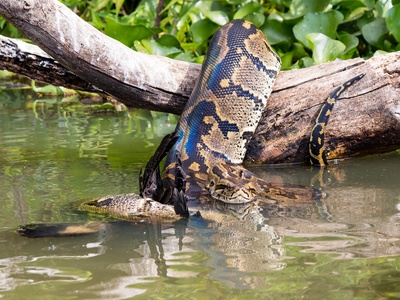
African Rock Python
Africa’s largest snake, capable of exceeding 5 meters in length. It is a powerful constrictor that preys on a wide range of animals, from rodents to antelopes. Populations are threatened by habitat loss and hunting for skin and meat.
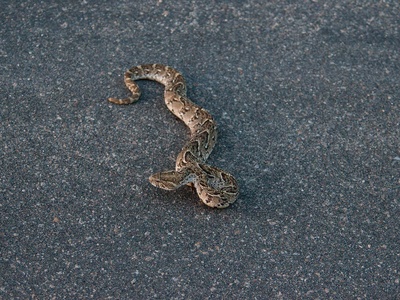
Puff Adder
A stout, slow-moving viper with a potent cytotoxic venom, responsible for many serious snakebites. It relies on its exceptional camouflage to ambush prey and is known for the loud hissing or “puffing” sound it makes when threatened.
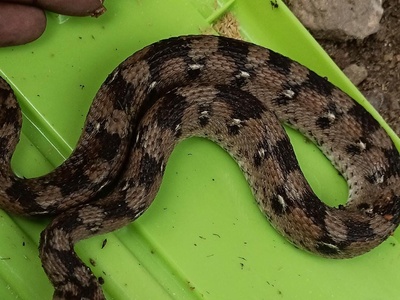
West African Carpet Viper
A small viper with a highly toxic hemotoxic venom, considered one of Africa’s most medically significant snakes. It produces a distinctive rasping sound by rubbing its serrated scales together as a warning. Its pattern provides excellent camouflage.
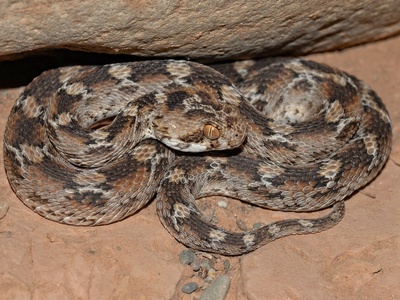
White-bellied Carpet Viper
Similar to its relatives, this small viper is dangerously venomous. It is distinguished by its pale, unmarked belly. It is nocturnal and well-camouflaged, preying on small rodents, lizards, and scorpions in arid environments.
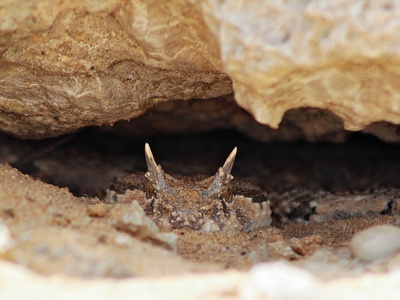
Saharan Horned Viper
An iconic desert snake, easily recognized by the pair of horn-like scales above its eyes, though some individuals lack them. It is a nocturnal ambush predator that uses sidewinding locomotion to move efficiently across loose sand.
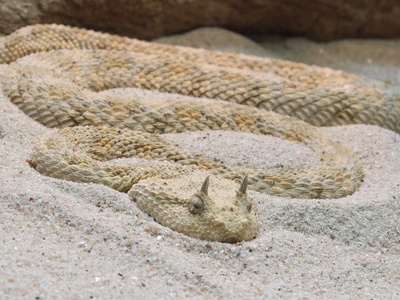
Sahara Sand Viper
A small viper that is a master of camouflage, often burying itself in the sand with only its eyes and snout exposed. It lacks the horns of its relative, *C. cerastes*. It is a nocturnal hunter that ambushes small lizards and rodents.
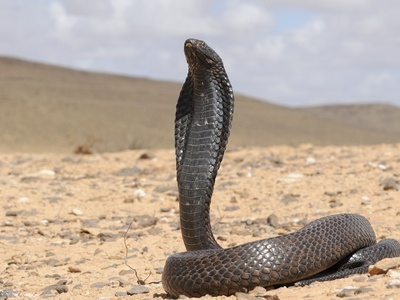
Egyptian Cobra
A large, famous cobra known for its classic hooding display. It possesses a potent neurotoxic venom. This species is historically significant, often identified as the asp of ancient Egyptian mythology and royalty.
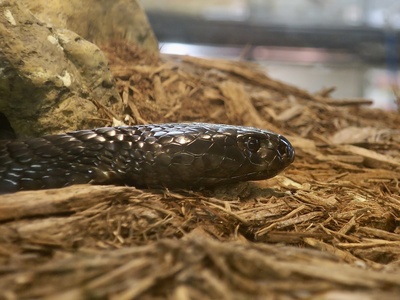
Black-necked Spitting Cobra
Famous for its ability to accurately “spit” or spray venom into the eyes of a perceived threat as a defense mechanism. The venom causes intense pain and blindness. It is a highly adaptable snake, often venturing into villages.
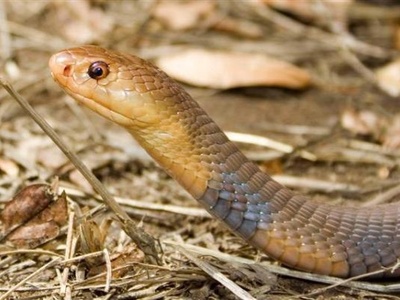
Katian Spitting Cobra
A smaller spitting cobra, typically yellowish-brown to gray. Like its relatives, it can spit venom with high accuracy. It is an active forager, hunting for amphibians, rodents, and other snakes both day and night.
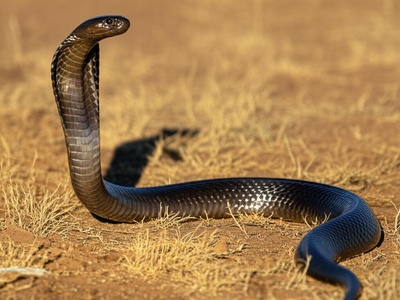
Senegalese Cobra
A large, typically dark-colored cobra previously grouped with the Egyptian cobra (*N. haje*). It is a powerful and dangerously venomous snake that preys on a variety of vertebrates in savanna habitats.
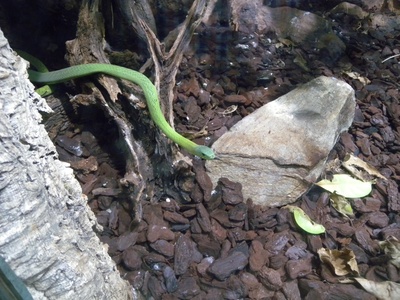
Western Green Mamba
A slender, agile, and highly arboreal snake with brilliant green scales. It possesses a potent neurotoxic venom. It spends most of its life in trees, hunting birds, eggs, and small mammals with incredible speed.
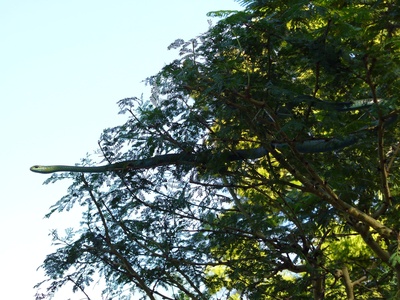
Boomslang
A large, slender snake with exceptionally large eyes and a potent hemotoxic venom delivered by rear fangs. Its coloration is highly variable, ranging from green and brown to black. It is shy and rarely bites humans unless severely provoked.
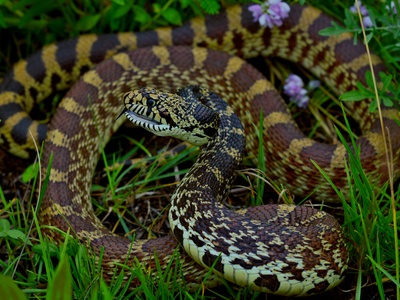
Hissing Sand Snake
A very fast, slender, and alert diurnal snake. It actively pursues its prey, which includes lizards, frogs, and small mammals. It is only mildly venomous and not considered dangerous to humans, though a bite can cause local swelling.
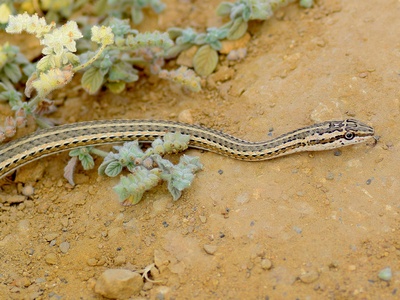
Schokari Sand Snake
A slender, fast-moving snake adapted to desert life. Its coloration, often sandy with stripes, provides excellent camouflage. It is a diurnal hunter of lizards and small rodents, using its speed to chase them down.
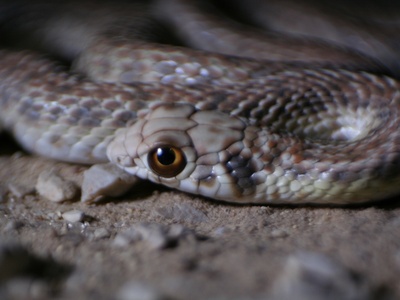
Moila Snake
A large, rear-fanged snake with a prominent brow ridge giving it a “fierce” look. It is a powerful and active diurnal predator of lizards and rodents. It can inflate its neck and hiss loudly when threatened.
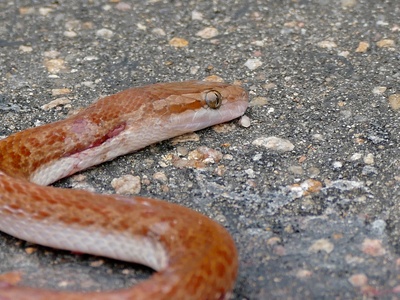
Brown House Snake
A harmless, nocturnal constrictor often found near human dwellings, where it is a beneficial predator of rodents. Its color is typically uniform brown, and it is known for its placid temperament.
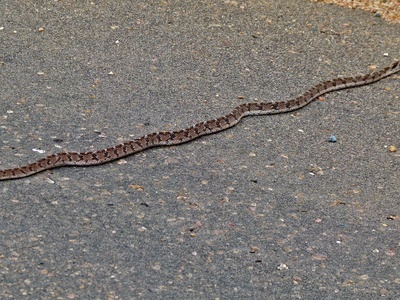
Common Egg-eater
A specialist predator that feeds exclusively on birds’ eggs. It has a highly flexible jaw and reduced teeth, and its vertebrae have projections that crack the eggshell internally. After swallowing the contents, it regurgitates the crushed shell.
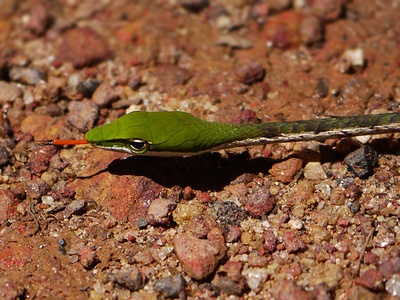
Forest Vine Snake
A master of camouflage, this snake’s slender body, elongated head, and gray-brown pattern make it look exactly like a vine or dead branch. It is a rear-fanged species with a potent hemotoxic venom and hunts lizards and frogs by ambush.
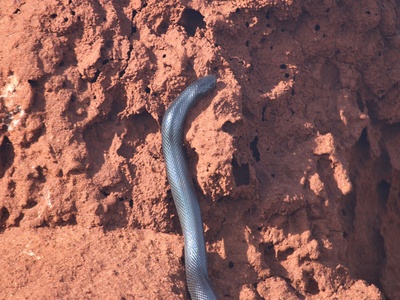
Small-scaled Burrowing Asp
A strange and dangerous snake with fangs that can be protruded from the side of its mouth, allowing it to bite without opening its jaws. It lives underground and preys on sleeping rodents in their burrows. Its venom is highly toxic.
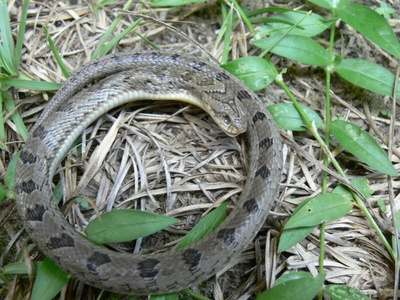
West African Night Adder
A small, stout adder most active at night, especially after rainfall, when it hunts for toads and frogs. It has a distinctive dark V-shaped marking on its head. Though venomous, its bite is not typically life-threatening to humans.
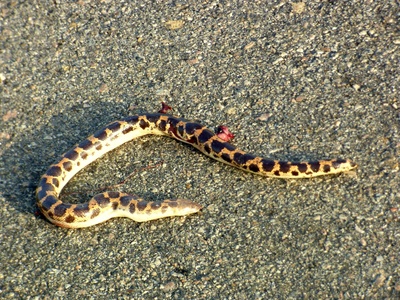
Müller’s Sand Boa
A small, stout-bodied boa that spends much of its time burrowed in loose sand. It is a nocturnal ambush predator, waiting for small rodents and lizards to pass by. It kills its prey by constriction.

Dorr’s Racer
A beautifully colored snake, often with a blue-gray body, yellow speckles, and a vibrant orange or red tail. It is a swift, diurnal lizard-eater adapted to life in rocky, sun-baked environments.
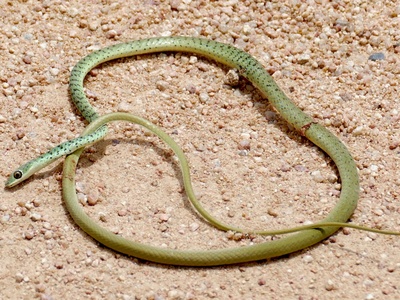
Spotted Bush Snake
A slender, graceful, and fast-moving snake that is an excellent climber. Its bright green and black speckled pattern provides perfect camouflage in foliage. It is non-venomous and actively hunts geckos, lizards, and frogs in trees and shrubs.
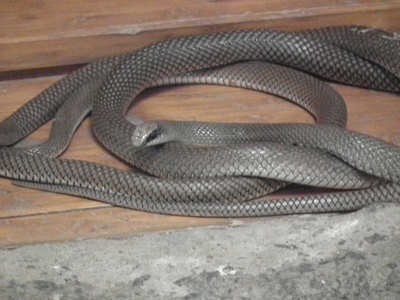
Rufous Beaked Snake
A large, fast snake recognized by its hooked, beak-like snout, which it uses to dig for prey in loose soil and leaf litter. It is a powerful constrictor and is only mildly venomous, preying on rodents, lizards, and other snakes.
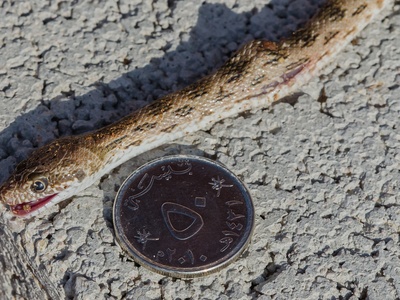
Diadem Snake
A large, non-venomous constrictor with a distinctive pattern of dark, diamond-shaped blotches on a lighter background. It is a powerful hunter of rodents and birds, often found near oases or in agricultural areas.
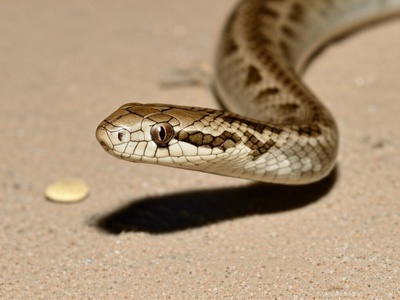
North African Cat Snake
A nocturnal, rear-fanged snake with vertical pupils, similar to a cat’s. It is a specialist predator of lizards and geckos, which it envenomates and swallows. Its venom is mild and not dangerous to humans.

Algerian Threadsnake
A tiny, blind, burrowing snake that resembles an earthworm. It spends its entire life underground, feeding on the eggs, larvae, and pupae of ants and termites. It is completely harmless to humans.
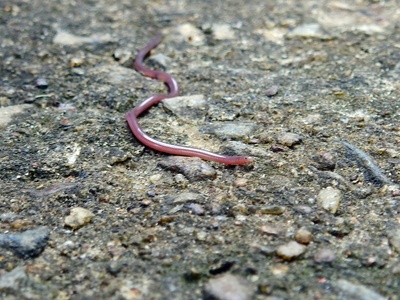
Common Blind Snake
A small, pinkish, worm-like snake that is entirely blind, with its eyes reduced to small dark spots beneath the scales. It is a burrowing species that feeds primarily on ant and termite larvae, located by scent.
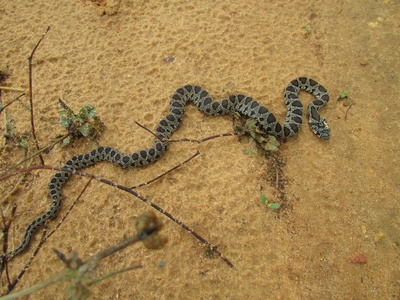
Horseshoe Whip Snake
A large, fast, and aggressive but non-venomous snake. It is named for the horseshoe-shaped mark on its neck and the diamond pattern along its back. It is an active diurnal predator of lizards, rodents, and birds.
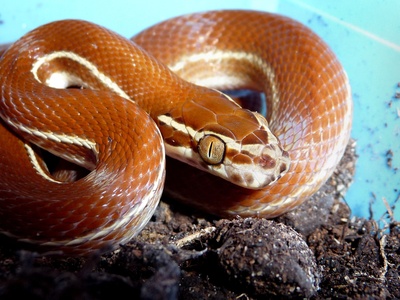
Striped House Snake
A harmless nocturnal snake, easily identified by the two distinct pale stripes on each side of its head. Like other house snakes, it is a beneficial species that helps control rodent populations in and around villages.
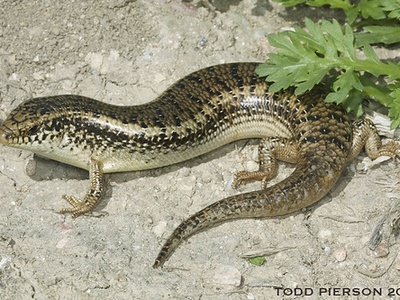
Ocellated Skink
A smooth, glossy skink with a cylindrical body and small legs. It is known for its “sand-swimming” ability, quickly burrowing into loose soil to escape predators. Its body is covered in small, eye-like spots (ocelli).
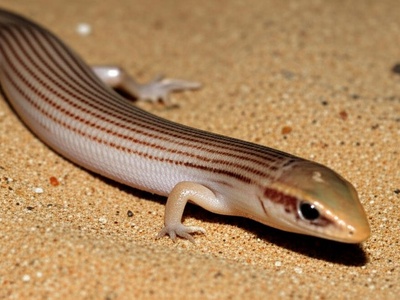
Band-bellied Skink
A specialized lizard with a wedge-shaped snout, smooth scales, and reduced limbs, all adaptations for burrowing or “swimming” through loose sand. It is rarely seen on the surface, living a secretive life underground.
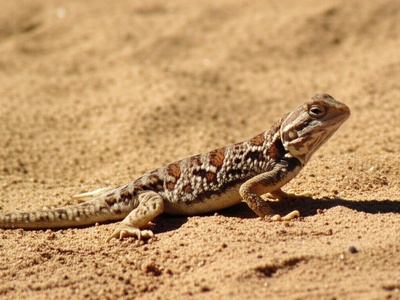
Changeable Sand Lizard
A small, ground-dwelling agama that relies on its cryptic sandy coloration to avoid detection. It can change its color to better match its background or for thermoregulation. It primarily feeds on ants and other small insects.
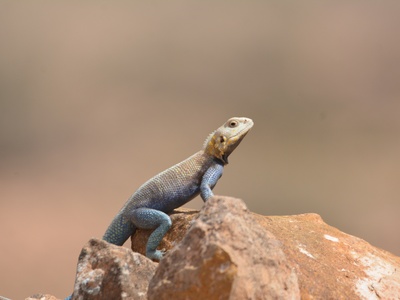
Bibron’s Agama
A robust rock-dwelling lizard found in the arid massifs. Breeding males are spectacular, with a bright blue head and yellow forelimbs, while females and juveniles are more cryptically colored. They are territorial and live in colonies.
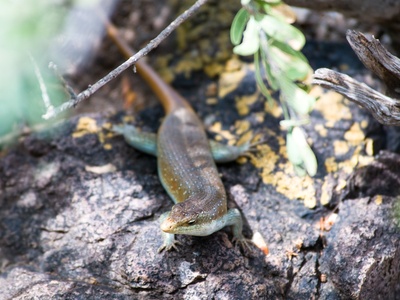
African Five-lined Skink
A large, robust skink with a powerful build. Juveniles have distinct light lines, but these often fade in adults, which become a more uniform brownish-bronze. It is a secretive forager, often found in leaf litter.
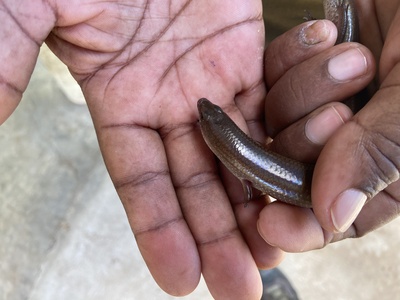
Peter’s Writhing Skink
A curious, snake-like skink with tiny, almost useless legs. It moves by writhing its long, cylindrical body. It is a fossorial species, burrowing through loose soil and leaf litter in search of insects.
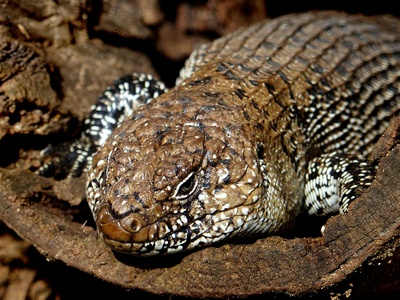
Banded Skink
A large, nocturnal, and burrowing skink with a striking pattern of broad black bands on a yellow or orange background. Its robust body and strong limbs are adapted for digging extensive burrows where it spends the day.
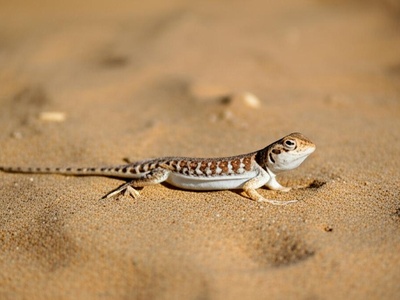
Northern Fringe-toed Lizard
A small lizard perfectly adapted to life in sand seas. Its fringed toes provide excellent traction for running at high speeds across loose sand to chase insect prey or escape from predators like birds and snakes.
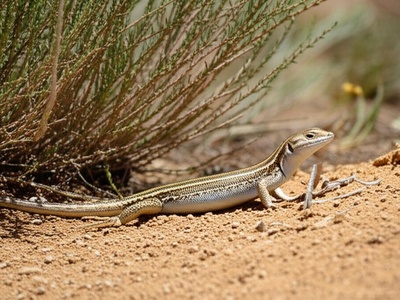
Long-tailed Sand Lizard
A slender, active lizard with an extremely long tail, often more than twice its body length. It is a diurnal, fast-moving forager that digs insects and other arthropods out from the base of bushes.
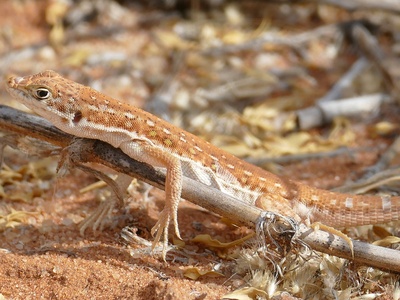
Spotted Sand Lizard
A small, diurnal lacertid lizard with a pattern of dark spots and light ocelli that provides excellent camouflage on stony plains. It is a heat-loving species, often remaining active during the hottest parts of the day.
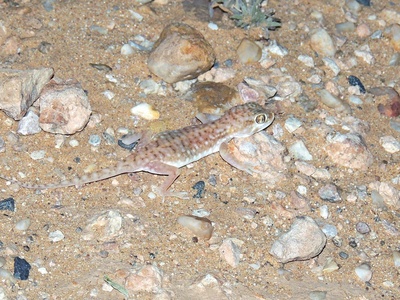
Elegant Gecko
A small, slender gecko with large eyes and spindly legs. It is a ground-dweller, active at night hunting for small insects. Its pale, sandy coloration provides camouflage against the desert substrate.
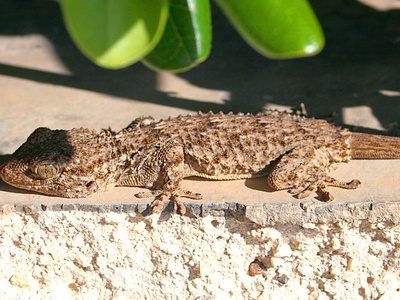
Northern Wall Gecko
A medium-sized, robust gecko that is an agile climber. It is nocturnal and often found near human settlements, where it hunts insects attracted to artificial lights. It can produce a loud, repetitive clicking call.
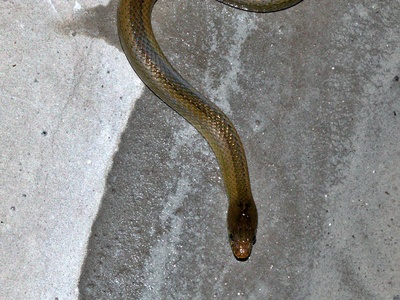
Olive Marsh Snake
A small, semi-aquatic snake that is an excellent swimmer. It is non-venomous and feeds almost exclusively on frogs and tadpoles. It is most active during the rainy season when its aquatic habitats are abundant.

West African Shovel-snout
A small snake with a specialized, hardened snout used for burrowing in sandy or loamy soils. It is nocturnal and feeds primarily on reptile eggs, which it uncovers by digging. It is completely harmless.
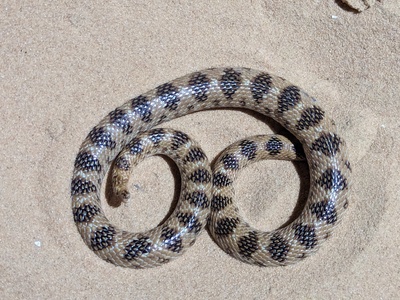
Diadem Sand Snake
A small, nocturnal burrowing snake with a sharp, pointed snout used for digging in loose sand. It is named for the dark, diadem-like marking on its head. It preys on small lizards and large insects.
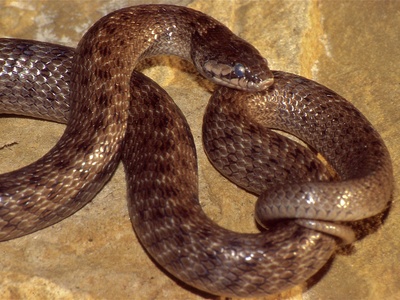
False Smooth Snake
A small, secretive, rear-fanged snake that is primarily nocturnal or crepuscular. It has a distinctive dark collar or blotch on its neck. It feeds almost exclusively on small lizards, such as geckos and skinks.
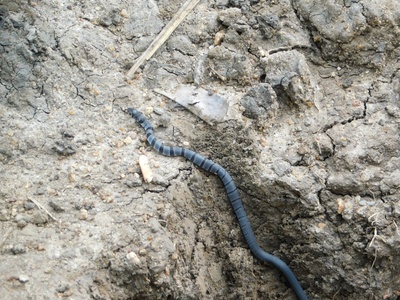
Semiornate Smooth Snake
A small, slender snake that is poorly known. It is terrestrial and thought to be diurnal, actively hunting for small lizards in leaf litter and grass. Its coloration provides camouflage in sun-dappled savanna environments.
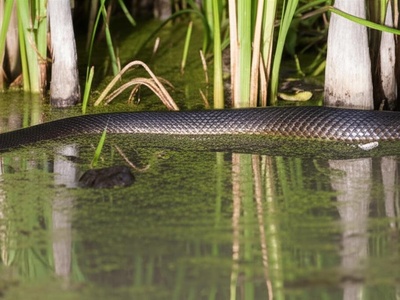
Smyth’s Water Snake
A large, powerful water snake that spends most of its life in rivers and swamps. It is an excellent swimmer and preys almost exclusively on fish. It is non-venomous but has a nervous disposition and will bite readily if handled.
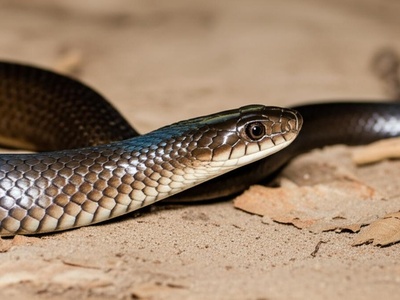
White-lipped Herald Snake
A common nocturnal snake, named for the white or pale upper lip scales that contrast with its dark head. When threatened, it flattens its head, hisses, and strikes aggressively. It is rear-fanged and specializes in eating toads.
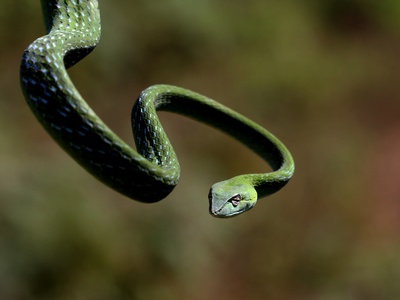
Slender File Snake
A small, slender, nocturnal snake with heavily keeled scales that give it a rough, file-like texture. It is a terrestrial species that forages on the ground for small frogs and lizards.
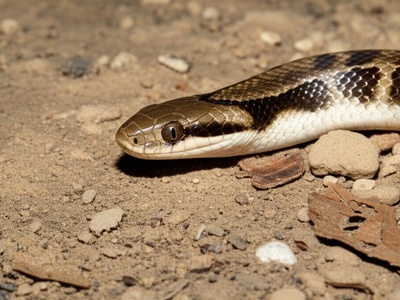
Semi-banded Wolf Snake
A small, constricting snake with large eyes and vertical pupils. It is named for the wolf-like teeth at the front of its mouth, used to grasp slippery prey like skinks. It is often found hiding under logs or rocks during the day.
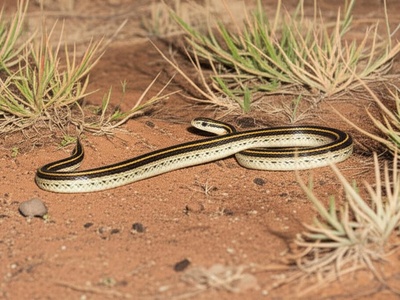
Ornate Sand Racer
A slender, fast-moving, and alert diurnal snake. It has a distinctive pattern of stripes and spots that help it blend into the grassy savanna. It actively hunts for lizards and other small vertebrates.
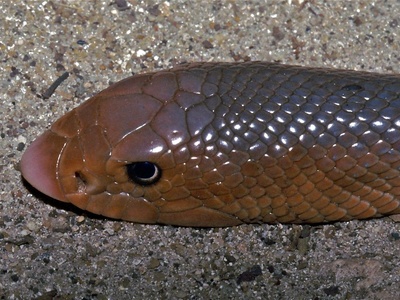
African Shovel-nosed Snake
A large, robust snake with a strongly shovel-shaped snout adapted for burrowing in compact soils. It spends much of its time underground and preys on rodents, often excavating them from their burrows.

Trape’s Garter Snake
A small, burrowing elapid snake with a distinctive pattern of black and white or yellow bands. It is nocturnal and preys on lizards, frogs, and other snakes. Its venom is neurotoxic, but it is not considered highly dangerous due to its small size.
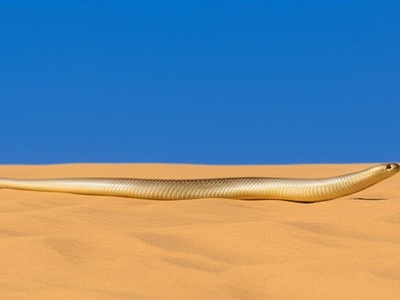
Egyptian Sand Racer
A very large and extremely fast sand snake, one of the fastest snakes in the Sahara. It is a diurnal hunter, preying on lizards, rodents, and birds in the hyper-arid desert environment.
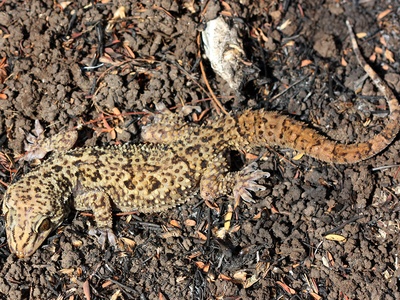
Rock Gecko
A small, diurnal gecko that lives in colonies on rocks and cliffs. It is unique among geckos for its complex visual signaling, using tail-waving and body posture to communicate with other individuals.
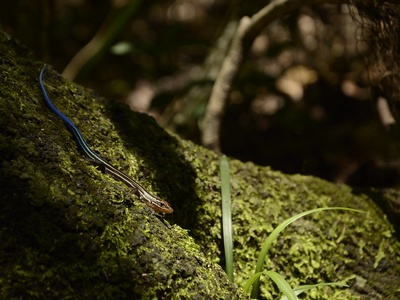
Southern Five-lined Skink
A large, arboreal skink often seen basking on tree trunks. It is characterized by its brownish color and spotted lip scales. It is an active predator of insects and other invertebrates found on trees.
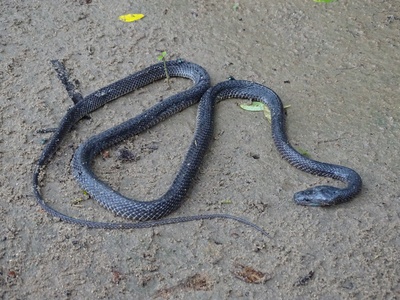
Western Forest File Snake
A semi-arboreal, nocturnal snake with strongly keeled (file-like) scales. It is a constrictor that preys on small mammals and frogs in the forest understory. Its rough scales may help it climb and grip prey.
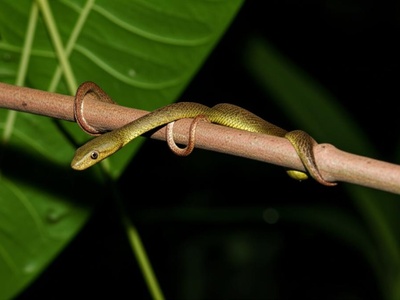
Weil’s Tree Snake
A slender, nocturnal, tree-dwelling snake with large eyes adapted for night vision. It is rear-fanged and preys on frogs and lizards in the forest canopy. Its coloration is typically uniform brown or olive.
